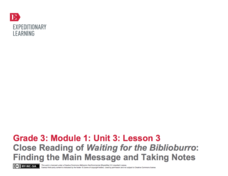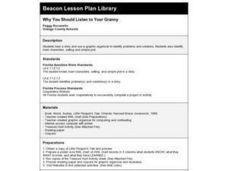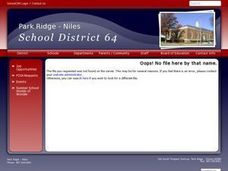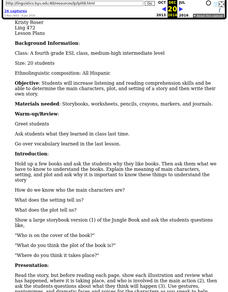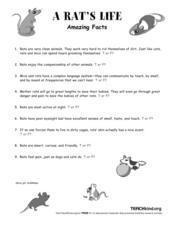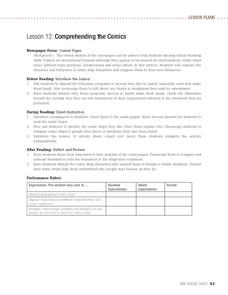Virginia Department of Education
Identifying the Main Idea in Fiction
Discovering the main idea in fiction is like uncovering buried treasure; one must persevere to locate it, and the reward is priceless. Scholars delve deep into leveled stories using three questions to aid in identifying the main idea.
EngageNY
Close Reading of Waiting for the Biblioburro: Finding the Main Message and Taking Notes
Expose your class to Waiting for the Biblioburro, narrative nonfiction that will act as the bridge between ficiton and informational texts to come. Class members do a close reading of the text, looking at excerpts instead of the whole...
Curated OER
WHY YOU SHOULD LISTEN TO YOUR GRANNY
Students hear a story and use a graphic organizer to identify problems and solutions. They also identify main characters, setting and simple plot. They illustrate one situation when they should listen to their parents.
Curated OER
An Author Study on Kevin Henkes
To better understand how the author Kevin Henkes uses the theme of friendship throughout his books, learners engage in several compare and contrast activities. The class reads several Henkes titles and discusses the similarities in...
EdHelper
George Washington's Socks by Elvira Woodruff
A solid, straightforward book report form is an excellent addition to your literature unit. Class members note the main characters, point of view, plot elements, and other important details from a story, adding their favorite part...
Curated OER
CAN WE SWITCH GENDERS OF STORY CHARACTERS?
Analyze characters and stories to identify stereotyping. Learners will examine the concept of character gender to evaluate bias in classroom story books. They are asked to read a story or play and change the gender of the character to...
Curated OER
Language Practice
The simple instructional techniques described in this plan will help young readers learn and practice basic reading skills and strategies. Before reading, introduce your readers to the meaning of main character, setting, and plot. Then...
Curated OER
Because of Winn-Dixie Scrapbook
Here is a fun resource that your kids will love. While reading the book Because of Winn-Dixie, they analyze the story's main characters by creating an online scrapbook. The purpose is to have them identify character traits and use...
Curated OER
Gus and Grandpa and the Two Wheeled Bike: comprehension skills
What a fantastic idea! Give these bookmarks to your readers to help them conquer pages 206-222 of Gus and Grandpa and the Two Wheeled Bike. They make inferences, conduct close reads, search for cause and effects, and focus...
Curated OER
Freckle Juice
Young scholars complete activities with the book Freckle Juice by Judy Blume. In this literature lesson plan, students read chapter one and brainstorm adjectives for the four main characters. They make a page of vocabulary words and...
Curated OER
A Rat's Life
Here is a two-page worksheet on rats and mice. Learners answer nine true/false questions about rats and mice, then compose answers to seven short-answer questions about these two rodents. Finally, they must compose a fictional story...
Curated OER
Comprehending the Comics
Students discuss and examine the comic strip section in newspapers. They compare and contrast themselves and others with the comic strip characters. With partners, they select a comic strip and complete a student activity sheet.
Curated OER
Story Pyramids
Young writers generate descriptive words. They use pictures of various landscapes (from books, magazines, or the Internet) and complete a story pyramid. The pyramid (included here) asks to describe the main character, the setting, and...
Curated OER
Just the Facts, Ma'am
Elementary learners identify the main elements of story structure and form questions to summarize their reading. They listen as the teacher reads a story and then write questions to determine (1) main characters, (2) setting, (3)...
Curated OER
Make an Alarm!
Students read the story, Dear Mr. Henshaw. They build an alarm system for something in the classroom, as the main character Leigh does to protect his lunchbox from thieves. Students explore alarms and use their creativity to create an...
Curated OER
Introduce: Comparison and Contrast
Class discussions can really make concepts come to life. The class discusses the differences between compare and contrast, read a book, then talk about ways they can compare events or characters in the story. Good leading question are...
Reed Novel Studies
The Princess and The Goblin: Novel Study
The Princess and the Goblin's main character, Irene, has a special bond is with her magic great-great-great grandmother that lives in a mysterious part of the castle. Worksheets focused on George MacDonald's novel offer eight vocabulary...
Curated OER
Scrapbook of Evidence
Young scholars read three different genres of fiction. They create a story map and brainstorm possible collage inclusions. Each student prepares a minimum of two scrapbook page entries for each text or passage. Students write beside each...
Curated OER
Can We Switch Genders of Story Characters?
Students read and review the main elements of a story. In this language arts lesson, students predict what the story read to them would have been like if the genders of the characters had been different. Students write a new...
Curated OER
Story Creation Magic: Character, Setting, Plot
Students review the terms plot, setting, and characters and examine how all of these elements are needed to make a story. They are given parts of stories and they try to identify all of those parts of the story.
Curated OER
Sam and the Lucky Money
Third graders read the story "Sam and the Lucky Money". Individually, they identify new key terms from the story. In groups, they examine the setting and discuss how it relates to the plots and characters. To end the lesson, they read...
Curated OER
Changes in Character
Third graders read the book Hi New Baby! and identify how the main character changes throughout the story. In this character lesson plan, 3rd graders write descriptive clues to explain the changes in feelings of the character.
Curated OER
Counteracting Media Stereotyping
Discuss media stereotypes with your emerging consumers. They view a television program to identify gender bias. After discussing the clip as a class, each learner writes a story showing more equitable roles. Or consider having them...
Curated OER
Let's Retell a Story
In this retelling a story worksheet, students review and discuss all the components involved in retelling a familiar story. Students choose a favorite story/book and fill out a graphic organizer retelling it in their own words. Students...

